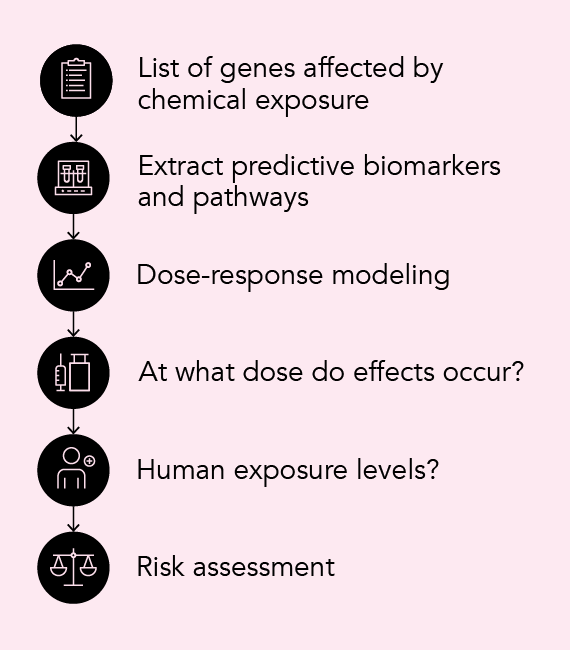
By identifying genes affected by exposure to chemicals and examining their response, GRDI researchers are developing a faster, less expensive and more accurate way to predict the potential toxicity of a chemical, and at what dosage toxicity occurs. (illustration: C. Yauk/J. Buick)
Long description of the image with the steps used in toxicity testing
- List of genes affected by chemical exposure
- Extract predictive biomarkers and pathways
- Dose-response modeling
- At what dose do effects occur?
- Human exposure levels?
- Risk assessment
With the support of funding through the Government of Canada's Genomics Research and Development Initiative (GRDI), researchers at Health Canada (HC) are reinforcing Canada's place as a pioneer in using genomics to support safe management of potentially hazardous chemicals—an area in which there is considerable room for improvement.
Filling a worldwide knowledge gap
There are tens of thousands of chemicals in the global environment, only a fraction of which have been tested to determine what risk they may pose to our health—largely because existing, animal-based test methods are slow and expensive. As HC Research Scientist Dr. Francesco Marchetti explains, "Using conventional methods, it can take months, even years to predict how a particular chemical may impact human health."
Building on close to two decades of GRDI-funded toxicogenomics research at HC led by Dr. Carole Yauk (now at the University of Ottawa), Dr. Marchetti is heading a project demonstrating how the latest cutting-edge genomics technology may revolutionize toxicity testing.
Seeing the bigger picture
"Rather than having to extract and examine one gene at a time to see the impact of exposure to a chemical, these technologies enable us to look at thousands of genes at once," says Dr. Marchetti. "This is essential information, because groups of genes work together in what we call pathways to carry out their functions in cells. Being able to see all the genes at once, we can learn how these genetic interactions may change in response to chemical exposure."
Faster, more accurate, lower cost
To understand the implications of those changes, the researchers have identified a number of toxicogenomic biomarkers that are associated with adverse health impacts. "By looking at which of those biomarkers have been activated, we can make very accurate predictions about the health effects of exposure to a chemical," says Dr. Marchetti. "The results are more accurate, and we also get them much faster and at less cost than we would with traditional testing."
Global recognition
While moving ahead with the current research, Dr. Marchetti is quick to acknowledge the foundational work of his predecessors.
"The work of my former colleague Dr. Yauk, for example, through a series of GRDI-funded projects at HC, has been key in establishing Canada as a leader in the field of toxicogenomics," says Dr. Marchetti. "It's a measure of the respect Dr. Yauk has earned for herself and for Canada that she chaired the US National Toxicology Program's Expert Panel in developing an approach for genomic dose-response modeling in the US."
Dr. Marchetti says GRDI investment in toxicogenomics research at HC has also been critical to establishing important international collaborations, which he says offer tremendous value to Canada—helping to secure Canada a prominent place on the world stage, at the same time assuring Canada has access to the knowledge being generated in other countries, helping to accelerate progress in the safe management of potentially hazardous chemicals for all Canadians.